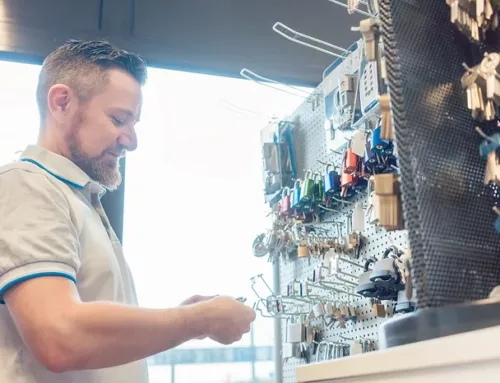Essential Guide to Rekeying Your Locks
Home security is a top priority for everyone. One key aspect of this is the control over who has access to your home.
Rekeying your locks plays a crucial role in this. But what does rekeying mean?
Simply put, rekeying is the process of changing the internal workings of a lock. This allows a new key to operate it, while the old one becomes useless.
This guide will walk you through the ins and outs of rekeying your locks. It will cover when and why you should consider rekeying, and how it can enhance your home security.
Whether you’re a homeowner, a renter, or a property manager, this guide will provide valuable insights.
So, let’s dive into the world of rekeying locks and discover how this simple process can significantly boost your home security.

When Should You Rekey Your Locks?
Rekeying locks is often necessary after specific events. Identifying these situations can help maintain your home’s security.
Consider rekeying in these scenarios:
- You lose your keys or they are stolen.
- You move into a new home.
- There is a change in occupancy or staff.
Also, after a break-in or when spare keys are lent out, rekeying can offer peace of mind. It ensures only trusted individuals have access.
These situations highlight the importance of prompt action. Rekeying quickly is vital to ensuring safety and preventing unauthorized entry.
The Benefits of Rekeying Your Locks
Rekeying your locks offers several advantages for home security. One significant benefit is cost savings compared to full lock replacement.
This process is quicker than installing new locks. It typically takes less time, enhancing convenience without sacrificing security.
Rekeying is also environmentally friendly. You reuse your existing hardware, reducing waste and promoting sustainability.
Additionally, it provides improved key control. You can prevent unauthorized duplication of old keys and manage access more effectively.
Ultimately, rekeying increases peace of mind. You establish a secure environment, knowing who has access to your home.
Rekeying vs. Replacing: What’s Best for Your Home Security?
When deciding between rekeying and replacing locks, consider your specific needs. Both have distinct advantages and drawbacks.
Rekeying is ideal for lost keys. It maintains existing hardware, offering a cost-efficient solution without compromising security.
Replacing locks is suitable if locks are damaged. It provides a fresh start, especially after severe wear and tear or break-ins.
Consider the following factors to choose:
- Condition of your current locks
- Budget constraints
- Need for enhanced security features
Evaluate each aspect to determine the best choice. Align your decision with your home security goals for optimal protection.
DIY Rekeying: A Step-by-Step Guide
Rekeying door locks yourself can save money. It also offers more control over your home security.
This project requires patience and attention to detail. Set aside time when you won’t be interrupted.
Start by familiarizing yourself with the lock’s parts. Understanding these components is crucial for a smooth process.
Take a systematic approach. Follow the steps carefully to avoid errors.
Misalignments can cause problems. Ensure each pin and spring is correctly placed.
After rekeying, test the lock multiple times. Verify that the new key works effortlessly.
DIY rekeying isn’t complicated but does take precision. Mistakes might lead to locking issues.
You may need assistance if problems arise. Don’t hesitate to consult a professional locksmith if needed.
If successful, you enhance your lock skills. Enjoy the satisfaction of increasing your home’s security yourself.
Keep your new key secure. It’s an essential part of maintaining your newly rekeyed locks.
Tools and Materials You’ll Need
Gather all materials before starting. Preparation ensures an efficient rekeying process.
You’ll need a rekeying kit, which includes pins and keys. Also, have the following tools ready:
- Screwdriver
- Pliers
- Tweezers
- Key gauge
A proper setup minimizes interruptions. Ensure your work area is well-lit and organized.
Double-check your kit to confirm all components are present. Missing tools can stall the process.
Removing the Lock Cylinder
Begin by removing the doorknob. Use a screwdriver for this step.
Next, locate the cylinder. It’s typically within the knob housing.
Carefully detach the cylinder. Handle it gently to prevent damage.
Changing the Pins
Once the cylinder is out, open it. You’ll access the pins inside.
Remove the old pins using tweezers. Follow the instructions in your rekeying kit.
Insert the new pins, matching their heights to the new key. Ensure alignment is precise.
Reassembling the Lock
With the new pins in place, reassemble the cylinder carefully. Reinforce the proper placement of the springs.
Place the cylinder back into its housing. Align it correctly with other components.
Use a screwdriver to secure everything. Ensure the knob is firmly in position.
Test the rekeyed lock several times. The new key should operate smoothly without resistance.
When to Call a Professional Locksmith
Rekeying can be daunting for some. If you lack confidence, contact a professional locksmith.
Certain locks are too complex for DIY attempts. High-security locks often require expertise beyond basic skills.
Time constraints are another reason to hire a professional. If you’re short on time, a locksmith can rekey quickly and efficiently, ensuring your home remains secure without the hassle.
The Cost of Rekeying vs. Lock Replacement
Understanding the costs is important for any security decision. Rekeying is often more budget-friendly than replacing locks.
Here’s a quick comparison:
- Rekeying: Lower materials cost, minimal labor.
- Lock Replacement: Higher hardware costs, increased labor needs.
Generally, rekeying offers a more affordable security upgrade, especially when dealing with multiple locks. Choose the option that best fits your budget and security needs.
Maintaining Your Rekeyed Locks for Longevity
Ensuring the longevity of your rekeyed locks is crucial for ongoing security. Regular maintenance checks can prevent unforeseen issues.
Lubricating your locks periodically helps keep them functioning smoothly. A lightweight lubricant is often most effective for this task.
Additionally, be gentle with your keys when locking and unlocking. Rough handling can cause wear and tear, reducing lock lifespan. By following these simple steps, your rekeyed locks will serve you well for years.
Legal and Insurance Considerations When Rekeying
Understanding legal responsibilities is vital when rekeying. In some regions, landlords must rekey locks between tenants. This step ensures tenant safety and complies with local laws.
Insurance policies can also be affected by rekeying. Some policies offer discounts for improved security measures. It’s worth verifying with your insurance agent to understand any potential impacts.
Moreover, always maintain records of lock changes. This documentation can be useful for legal reasons or when renewing your insurance. Keeping these considerations in mind helps safeguard both your property and your compliance.
Conclusion: Enhancing Your Home Security with Rekeyed Locks
Rekeying is a simple, yet powerful method to boost home security. It offers peace of mind and control over your lock system.
Choosing rekeying over replacement can be cost-effective and environmentally friendly. It effectively protects against unauthorized access.
Overall, rekeying your locks solidifies your home’s security. Whether DIY or via a professional, ensure your locks serve your safety needs.







